Los Angeles Police Department resources
Resources of the Los Angeles Police Department.
Police stations
The Department's deployment of officers has reflected the growth and changes of the City of Los Angeles since the late 19th century. The earliest police station (or "division" as the early ones were known - this term was originally meant to mean the Patrol Division but over time this term became commingled and substituted for what today we would refer to as the actual brick and mortar police building the divisions were housed within) was Central Division, located in what today would be known as downtown Los Angeles on the southeast corner of 1st and Hill Streets. This station opened in 1896 and as the Department's first dedicated police station (another had been located at 2nd/ Spring Streets, but was possibly a leased or rented storefront type of set-up). The Central Jail was located directly south of it. "Old Central" as it came to be known, housed not only Central Division but also many of the Department's headquarters units until its closure in about 1955 in favor of Parker Center. The following is a listing of other Los Angeles Police Stations through the years, along with their original division numbers:
- 01 Central Police Station.
- 02 Rampart Police Station (formerly Lincoln Heights Police Station, number reassigned in 1966)
- 03 Southwest Police Station (formerly University Police Station)
- 04 Hollenbeck Police Station (formerly Boyle Heights Police Station)
- 05 Harbor Division (result of combination between the San Pedro station and the Wilmington Substation in 1962)
- 06 Hollywood Police Station.
- 07 Wilshire Police Station.
- 08 West Los Angeles Police Station. (formerly Sawtelle Police Station)
- 09 Van Nuys Police Station. (formerly Valley Police Station)
- 10 West Valley Police Station (number formerly assigned to the Wilmington Substation)
- 11 Eagle Rock Division. This station's name was changed when moved to Highland Park (approximately 1920's) and then again to today's Northeast Police Station.
- 12 77th Street Police Station.
- 13 Newton Street Police Station.
- 14 Venice Police Station. Renamed Pacific Police Station.
- 15 Georgia Street Police Station. This station was deactivated and its number was later reassigned to North Hollywood Police Station.
- 16 Foothill Police Station.
- 17 Devonshire Police Station.
- 18 Southeast Police Station.
- 19 Mission Police Station.
- 20 Olympic Police Station
- 21 Topanga Police Station
The city's largest growth period was from approximately the late 19th century through the 1930s when the city grew at a geometric rate. Approximately 100 smaller portions were added to the original five square mile Pueblo. Of these, about 90 were formerly unincorporated county lands. The remaining ten portions had been their own incorporated cities. These included the cities of: Watts, Venice (originally Ocean Park), Hollywood, San Pedro, Wilmington, Barnes, Hyde Park, Eagle Rock, Sawtelle and Tujunga. Generally when the city consolidated another existing city, its police officers became LAPD officers with corresponding ranks and titles at the LAPD, per the city charter. LAPD would create a new Division, named after the city that had been consolidated and would continue using the prior city's police station, usually replacing these facilities with larger police stations within a few years.
Mobility
To patrol the 498 square miles (1,290 km2) of the city of Los Angeles, the police department utilizes a number of different types of vehicles:
Sedans
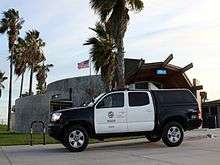
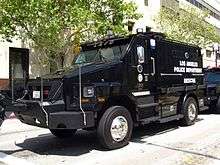
With few 9C1 Chevrolet Caprice vehicles remaining in the motor pool (as the final model year of the Chevrolet Caprice was 1996), the Ford Crown Victoria Police Interceptor is one of two sedans for patrol in the department fleet, the other being the newly approved 2008 Dodge Charger LX Police Special. Only the sedan is permitted to engage in a vehicle pursuit, pursuant to department policy. Like most police agencies throughout southern California, Los Angeles Police Department vehicles are ordered painted in black clearcoat with the roof, doors, and pillars painted white from the factory. The Department has used this black-and-white paint scheme since approximately 1940 with minimal modifications. Options available from Ford ordered by the Department today include the handle-bar spotlamps, 16-inch heavy duty steel wheels with chrome center caps, and ballistic panels within the two front doors.
Most police vehicles bear at least two rear bumper stickers: one reading "There's NO Excuse - For Domestic Violence" and another for "Watch The Road - Operation Traffix". On the rear side panel is a black and white sticker that reads "EMERGENCY DIAL 9-1-1 Fire Police Medical." The front doors bear the seal of the city of Los Angeles, the department slogan "to protect and to serve" as well as the citywide five-digit "shop number" and city department name (POLICE). The last three numbers of the shop number (used to identify all vehicles operated by the city) are reprinted on the roof to help air units visually identify cars. On the trunk is a number that identifies which division the unit belongs to (e.g., a 25 would be "South Traffic Division" or a 3 would be "Southwest Area").
These cars appeared on the NBC television drama Adam-12:
- 1967, 1968 and 1969 Plymouth Belvedere
- 1971 Plymouth Satellite
- 1972 AMC Matador
On September 11, 2015, the Mayor announced a plan to lease 160 battery electric vehicles and 128 plug-in hybrids. The police also loans a Tesla Model S and a BMW i3 for testing.[1][2]
Motorcycles

Kawasaki Police Motorcycles have represented the majority of the motorcycle vehicles in the motor pool with some Harley-Davidson motorcycles and increasingly, BMW motorcycles. Motorcycles are also painted black and white. These motorcycles carry a radio, code-3 equipment, a shotgun and documentation used by a police officer. During rain, motors are garaged, and traffic units patrol the city in sedans. LAPD also operates 3 electric motorcycles and 23 electric scooters.[2]
Air Support Division
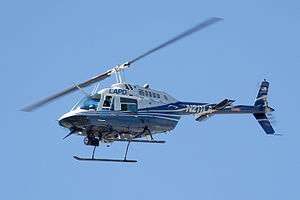
The LAPD maintains the second largest non-military airforce in the world. It maintains 21 helicopters and 1 fixed-wing aircraft.[3] The helicopters are painted silver and blue. The LAPD Air Support Division is slowly trading in their older Eurocopters for newer Eurocopter 125 models. The new models, however, are entering service with the more traditional black-and-white paint schemes similar to their department patrol cars. The letters LAPD appear on the top side of the aircraft in blue, capital letters.[4] Typical air units include 14 Eurocopter AS-350B2 AStars, 4 Bell 206B-IIIs and 1 Bell UH-1 (no longer in service, due to maintenance issues and replace by Bell 412 for homeland sercuity). The aircraft come with a wide variety of electronics and equipment that include a 30 million candlepower "Nightsun" spotlight, optical FLIR cameras and electronically stabilized binoculars, a LoJack signal receiver, police radios in addition to the built-in aviation radios.
Two officers with at least three years of patrol car service fly in each air unit; they are armed and able to land and make arrests in areas not accessible by other means. They depart from the Hooper Heliport in downtown Los Angeles, and the Van Nuys airport.
Air units provide information with regards to barricaded suspects, suspects fleeing on foot or in a vehicle, violent incidents involving large numbers of individuals, and then some. Air units are automatically requested when initiating a traffic stop on a "code 37" vehicle, or suspect with known wants or warrants that are a felony in order to limit the potential for a vehicle pursuit.
Air units do not fly during poor weather (particularly dense fog) due to aviation safety.
Bicycles
Occasionally, "cycle" units go on patrol (usually in large numbers), especially during special events to provide fast and easy access to police assistance. Bicycle units may go on patrols lasting between 10–25 miles during any given beat. Bicycle units train rigorously (mainly in the hills of Elysian Park near Academy Road and Dodgers Stadium). The bicycles used by the Los Angeles Police Department are manufactured by Giant.
Horses
Metro Division, known for its famous Special Weapons and Tactics (SWAT) unit, also has an Mounted Unit that consists of approximately 40 police horses. Normally deployed during special events, specially trained officers also wear jeans as the pants to their uniform along with boots and a Stetson hat with the same Police shield as the one worn on the brim of the traditional police cap. Equestrian units normally appear in the city only during special occasions. Metro Division is also responsible for the K-9 units, making Metro Division responsible for not only police horses, but also for police dogs (which also wear ballistic vests). Narcotics and Bomb K-9 units belong to different divisions.
Radio
Inspired by a contest in 1924, Police Chief R. Lee Heath ordered his staff to investigate the use of radio to "more quickly dispatch officers to where they are needed." It was not until Police Chief Roy E. Steckel, however, that the department would be assigned its first Federal Communications Commission (FCC) license. On May 1, 1931, KGPL began broadcasting at 1712 kHz, just above the commercial radio broadcasting frequencies. Later, this was changed to 1730 kHz. Any citizen could monitor outgoing police radio traffic on their home sets. The system was "one way" until the mid-1930s when mobile transmitters were installed in patrol units.
Today, telephone calls into the department for police service are handled by the Communications Division. First, an Emergency Board Operator (EBO) answers calls placed to 9-1-1 (with a lower number of operators assigned to the non-emergency 1-877-ASK-LAPD). A call for service results in an incident number, which resets to the number 1—citywide—at midnight each night. Upon receiving the incident, the Radio Telephone Operator (RTO) will go on the air to broadcast to the division (with the option to simulcast on bureau-wide, geographically-adjacent or citywide frequencies). Today, RTOs provide the following information in what is known as a crime broadcast:
- to whom this message is intended (a particular unit, a certain division's units, or, "all units"),
- the type of crime that just occurred (usually by California Penal Code but sometimes an abbreviation, established by the Communications Division),
- how long ago the crime occurred,
- where,
- a quantity of suspects (if more than one),
- a description of the suspect(s), their clothing and/or other uniquely identifiable attributes, if available, with what they might be armed.
- Additional details may include information about the "PR" (person reporting) or simply instructions to "monitor comments for further" (a direction to responding officers to read about the incident on their in-car Mobile Data Terminals).
- The broadcast always concludes with a code (such as Code 3 or Code 2 for immediate response but without siren with red and blue lights), the incident number and the "RD" or reporting district (a numbered area within the division).
There may also be a request by the RTO for the responding unit handling to identify.
A fictitious example of a radio call might begin with tones (to alert patrol units that a broadcast will follow), "Any central unit, a 211 just occurred at 714 south Broadway Street at the Footlocker. Suspect was a male, white, six-foot seven, approximately 280 pounds; shaved head, black eyes, goatee, white T-shirt, dark baggy pants. Weapon used was a revolver. Monitor comments for additional. Code 2. Incident number 555 in RD 193."
"Control" (the radio name for Communications division) as well as units in the area also use a wide variety of codes, common ones include:
- Code 1: answer your radio
- Code 2: respond immediately to location, no lights or siren, obey all traffic laws
- Code 3: respond immediately with lights and siren to location, exemption from traffic laws permitted with lights and siren
- Code 4: no further units need respond, return to patrol
- Code 4-Adam: no further units need respond, suspect not in custody, units en route to the scene position or patrol in strategic areas near the scene
- Code 5: Stakeout, marked police cars must avoid location
- Code 6: unit has arrived to location, officers investigating
- Code 6-Adam: unit has arrived, may need further assistance from nearby units
- Code 6-Charles: Dangerous suspect (usually felony want or warrant reported); one-officer units stand-by for assistance
- Code 7: meal break request, accompanied by location of unit (not granted when their bureau or the city goes on "tac" or tactical alert, which allows the department to draw any available unit from any division if necessary)[No Longer Used After Late 2008]
- Code 8: fire reported in area of high fire hazard or threat to firefighting personnel
- Code 8-Adam: units requested to scene of fire for traffic and crowd control
- Code 10: request to clear frequency for broadcast of want/warrant information
- Code 12: False Alarm
- Code 20: Notify Media or Often Used To Advise Others That media Is On Scene
- Code 30: Burglar Alarm (can be Code 30-Silent)
- Code 37: Vehicle is Reported Stolen (Code 6-Charles is given if vehicle license check produces dangerous suspect or felony want or warrant information)
- Code 100: units in position to intercept fleeing suspect
- Code Robert: Request for deployment of Urban Police Rifle (Code Robert-UPR) or shotgun slug ammunition (Code Robert-Slug) to location
- Code Tom: Request for deployment of taser to location
NOTE: A unit that responds Code-3 must state their starting location (e.g. intersection or street address), after which the RTO broadcasts a Code 3 notification, announcing the unit number is responding Code-3 from that starting location to the location of the distress call.
Typical radio traffic (usually not simulcast citywide) includes the activity generated from traffic stops. A patrol unit may radio control that they are "code 6" on a traffic stop, to which control will give the "Roger" acknowledgement. Additional broadcasts will be requests for information on "cal IDs", or CalOps (the numbers that appear at the top of California Department of Motor Vehicle driver licenses) or on vehicle license plates. The result of which provides all of the expected details about the subject plus important details such as whether or not the licensee has any wants or warrants, FTAs (failure to appear in court) or FTPs (failure to pay a fine), etc. In the case of a vehicle, whether or not it is Code 37. Off the air and via MDT, officers can also see to whom the vehicle is registered.
In the event a Code 6 Charles is broadcast, the unit in question must verify their location, advise if they are Code 4 and the nature of the Code 4 (e.g. Suspect in custody, Common Name, Information Only or Wrong suspect.)
A noticeable characteristic of police broadcasts is the expedited nature of crime broadcasts; due to the number of broadcasts that need to be made at any given moment of the day, each transmission is necessarily as brief as possible. As a standard of police professionalism, RTOs are trained to use a tone that is strictly business-like.
Digital frequencies
After the parade in Los Angeles celebrating the Los Angeles Lakers 2001 NBA championship title, the police department switched from analog frequencies to digital frequencies. This ended a long-lasting era of the public having easy listening access to police broadcasts that started when the department had initially set up agreements with a local, commercial AM radio station to interrupt regularly scheduled programming for a crime broadcast. Officers were tuned to a specific radio station. However, as the amount of broadcasting needed increased, the department established its first transmission tower in Elysian Park and eventually began broadcasting over dozens of frequencies in the 400 MHz and 500 MHz ("T-band") ranges. These digital transmissions can be monitored on a proper Uniden Bearcat or Radio Shack digital scanner.
Radio cars
From the perspective of control, each unit is represented by an LAPD-specific callsign. Typically, a callsign is made up of three elements: the division number, the unit type and the "beat" number. For example, division 1 is Central Division (or, now, "Central Area"), an "A" is patrol unit with two officers and their patrol area number can be a number like 12. Such a unit would identify themselves as 1-A-12 (or 1-Adam-12, using the LAPD phonetic alphabet). There are several patrol types:
- A: Two officer patrol unit ("Adam")
- D: SWAT ("David")
- E: Ticket writing car
- L: One officer patrol unit. ("Lincoln"); ( "X" or "T" units shall use the letter "L" following the regular service letter when applicable.):traffic supervisor, TL units usually carry the rank of Sergeant
- M: Motorcycle unit ("Mary"); (MQ: motorcycle on special assignment, MQ: DUI enforcement)
- C or "cycle": Bicycle unit
- CP: Command Post
- FB: Foot Beat (Foot Patrol)
- T: Traffic investigator ("Tom")
- TL: Traffic single officer car or field supervisor (a Sergeant in a Traffic Division)
- SLO: Senior Lead Officer
- G: Gang enforcement unit ("George")
- H: Detective ("Henry")
- J: Juvenile Investigator
- N: Narcotics
- R: Metro Unit
- W: Detective ("William")
- U: Report-taking Unit ("Union")
- V: Vice ("Victor")
- OP: Observation Post (normally, a small bus operating as a mobile command unit for major incidents)
- Q: Special detail (Not to be assigned radio calls. Works on a specific crime mission)
- X: Extra patrol ("X-ray")
- Z: Special detail ("Zebra"); (Not to be assigned radio calls. Works on a specific crime mission)
The immediate supervisor of any patrol officer is called a Field Supervisor, which typically have beats that end in zero beginning from 2 through 7 (for example, 7-L-60 for a Wilshire Area supervisor). The Watch commander is a usually a lieutenant I at a geographic division. Their radio code always ends in L-10 (e.g., the watch commander at division 6 or Hollywood Area station is always 6-L-10). The Watch commander is responsible for the geographic area (e.g. "Southwest Area") and reports to the area patrol captain I.
Radio equipment
Officers out of their cars are able to communicate over the air using portable Motorola radios nicknamed ROVERs ("Remote Out of Vehicle Emergency Radios"). These hand-held radios are currently Motorola XTS-5000 Models With Some Motorola Astro digital SABER models still being used by very few officers and some still inside older police vehicles. Originally, Motorola MX-series analog handheld units were used when the transition from VHF to UHF "T-band" dispatch/tactical frequencies was made in the early 1980s. Prior to that time, portable 2-way radios (known in LAPD jargon then as "CC units") were either VHF or UHF, mainly Motorola HT-3rd century and HT-220's, stocked in small quantities, and used mainly by specialized units such as Metropolitan division, SWAT (Special Weapons & Tactics), SIS (Special Investigations Section) and Narcotics divisions as stakeout tools. Another use was for footbeats "FB" units, mainly in Central division, in the late 1970s and early 1980s. ROVERs are normally utility belt-mounted. For convenience, smaller, corded, hand-held microphones can be plugged into these radios and then clipped to parts of the uniform shirt such as a front pocket or shoulder loop.
Ranks of the LAPD
The ranks of the LAPD are as follows:
- Police Officer I, II, & III;
- Police Officer I & II have no insignia of rank
- Police Officer III has two silver chevrons
- Police Officer III+1, P3's who are in advanced pay grades (including Senior Lead Officer) have two silver chevrons above a silver star.
- Police Detective I, II & III;
- Detective I has two silver chevrons above a silver lozenge; Detective II has three silver chevrons above a silver lozenge; Detective III has three silver chevrons above a silver rocker, with a silver lozenge in between; the Detective III rank is equivalent to the rank of Sergeant and the next step is Lieutenant.
- Police Sergeant I & II;
- Sergeant I has three silver chevrons; Sergeant II has three silver chevrons above a silver rocker.
- Police Lieutenant I & II;
- Lieutenant I & II both wear one silver bar.
- Police Captain I, II, & III;
- Captain I, II & III all wear two silver bars.
- Police Commander;
- Commander wears one silver star.
- Police Deputy Chief I (Deputy Chief);
- Deputy Chief wears two silver stars.
- Police Deputy Chief II (Assistant Chief);
- Assistant Chief wears three silver stars.
- Chief of Police
- Chief wears four silver stars.
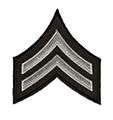
Police Officer III 
Police Officer III+1 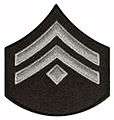
Detective I 
Detective II 
Detective III 
Police Sergeant I 
Police Sergeant II 
Lieutenant 
Captain 
Commander 
Deputy Chief Of Police 
Assistant Chief Of Police 
Chief Of Police
References
- ↑ "LAPD Blog: Mayor Garcetti And City Departments Commit To Largest City-Owned Fleet Of Pure Battery EV Vehicles In America". Lapdblog.typepad.com. 2015-09-11. Retrieved 2016-04-29.
- 1 2 Brandom, Russell. "The LAPD has a Tesla now". The Verge. Retrieved 2016-04-29.
- ↑ "Archived copy". Archived from the original on May 4, 2007. Retrieved May 3, 2007.
- ↑ "LAPD Air Support — Police Helicopter Pilot". Policehelicopterpilot.com. Retrieved 2016-04-29.
